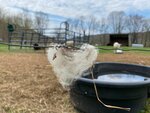
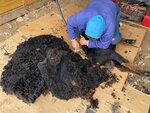
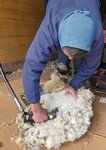
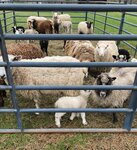
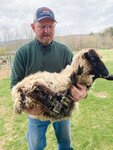

WALTON - Sheep are among the most versatile livestock animals, offering a multitude of resources - from meat and milk to wool. For centuries, sheep have been the epicenter of many rural economies, with specific breeds cultivated for their ability to produce top-tier wool, high-quality meat, or in some cases, both.
There are intrinsic characteristics that contribute to wool quality, including:
Fiber diameter: The diameter of wool fiber, measured in microns, is a key determinant of wool quality. The thinner the fiber, the softer and more comfortable the wool, making it more suitable for garments that come into direct contact with skin.
Crimp: The natural wave pattern found in wool is known as crimp. Wool with a higher degree of crimp is generally more elastic, stronger, and easier to spin.
Staple length: This is the length of the lock of wool. Longer staples are often preferred because they can be spun into longer threads.
Luster: This refers to the shine or gloss of the wool. Wool with a higher luster is often more visually appealing and can command higher prices.
Yield: Yield refers to the amount of clean wool derived from raw fleece. Higher yields are often more economically desirable.
Color: The natural color of the wool can affect its value. White wool is often more desirable because it can be dyed to any color.
Once a sheep is shorn, wool can be sold to a “wool pool,” which in turns sells bulk quantities of wool to manufacturers. It can also be felted for any purpose or spun for knitting or crocheting.
Some sheep farmers discard or dispose of the wool. Some use it for insulation. Wool is resistant to heat, water, wear and tear. It does not wrinkle easily in garment form. Wool is also fire resistant and moisture wicking. It can soak up to as much as 30% of its weight in moisture without feeling wet.
Dust mites don’t like wool. They prefer hot, humid environments that are more common in synthetic or down products. Wool is hypoallergenic.
Wool is also a sustainable resource that does not harm animal or plant life. Unlike some man-made fibers, most wool is also produced organically without the use of treatment chemicals. Wool can also help keep you cool. The breathable quality of wool means sweat doesn’t weigh it down.
There have been fewer and fewer entries in each category of competition over the past 10 years, fair exhibit entry manager Diane Benedict said. She manages entires for everything from pickles to livestock, she said. She is uncertain whether the decrease is reflective of a changing economy or a lack of interest, or both. But, she said, she hopes to see numerous exhibit entries in all categories and classes at this year’s fair.
There will be a fleece competition Tuesday, Aug. 15 in various classes including white: fine, medium and long wool; and natural color: fine, medium and long wool. There will be grand champion and reserve grand champion awards for both categories.